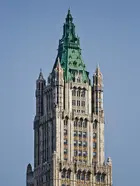One of Alchemy Properties' high-profile residential projects is the grand Woolworth Tower Residences, an elegant and painstaking renovation of Cass Gilbert's landmarked 1912 Woolworth Building. CityRealty had the opportunity to speak to Alchemy Partner Alexander Saltzman about his inspirations behind the stunning renovation of the Woolworth Tower Residences. Through the laborious process of renovating the former office of Frank F. W. Woolworth (or simply “Frank,” as Saltzman endearingly refers to him) into 33 luxury residences, Alchemy uncovered a treasure trove of hidden gems, from the ornate coffered ceilings which once adorned Woolworth’s 40th floor office and are now installed the new street-level residences’ lobby, to the long-hidden signatures of the original builders under years of plaster and paint.
In this article:
How did Alchemy get involved with the Woolworth building?
The building came to us a result of a small handful of relationships. It wasn’t really for sale, then it was for sale, then someone was going to buy, and then they decided they wanted an experienced New York City condominium developer, and that was us. Alchemy had already done some properties downtown. We knew the area was transforming and yet, frankly, it transformed quicker than we even anticipated. The growth built upon itself. There was a critical mass here. People are living all around City Hall Park, Tribeca, and the Financial District. Ten to 20 years ago, none of this was here. People from Midtown and Uptown came here to shop, eat, and for entertainment. We saw the area was on the brink of a transformation but we didn’t necessarily see the Woolworth as an anchor - although we did see it certainly had its place. It is not that it doesn’t matter where Woolworth is, I mean if it was in the middle of farmland it wouldn’t work. But with all the activity of Westfield and the World Trade Center, it was a very logical next step to know people would be living in this neighborhood.
This project was clearly a labor of love as well as a very viable residential project. What made the Woolworth building a good residential project in your eyes?
New construction is great because it is new and, frankly, easier than adaptive reuse. But we have always found that because adaptive reuse is harder, it's potentially more interesting. There are limitations on what that you can do because the structure is existing, but it's exactly those limitations that drive creativity. You have an existing framework so you either have to figure out how to fit into what is there already or figure out how to get our vision into that framework.
When we first walked through the building, we saw the restrictions but we also saw the amazing opportunities. The spaces between the huge windows in the tower lent themselves to an apartment layout. From street level, when you look up, you cannot tell that the windows are six to seven feet tall. When you're in the space and you see how your head only comes up halfway up these 4 x 7-foot windows, then you feel the size. The windows create a cadence within the facade that really lend themselves to residential spacing and layouts.
Beyond that, obviously, it was the Woolworth Building. This building has been an important part of the skyline since the beginning of the city, so adaptively reusing and securing its future was incredibly important to us. The creativity just jumped out of its walls because of its history and its potential to be residences. It truly felt like the building was originally designed to be residential.
Did you uncover anything surprising while renovating?
Every now and then, when the workers were filling gaps behind the plaster, they would find some stuffed newspaper in there, under the wire and plaster. Three different times, we came across newspapers that you could read the 1913 date on it. I have this great photo of some really ancient newspaper sticking out of the wall. As soon we tried to take it out, it turned to dust.
When we cleaned some of the seals in order to make other connections and modifications, we were able to see the Carnegie logo, which was where they were milled. The whole building is such an interesting piece of American history.
But really special, in the top of the building, at the pinnacle, there were multiple layers of years of old paint that had all fallen off the plaster. Under that, we could see pencil signatures of the workmen who had been in the building at the time. Similar to the way American flags are signed and hoisted to the top of construction sites, these workmen wanted to pay tribute to the work they completed on this supertall tower. It was very cool that the paint popped off to reveal these signatures, to show the people who were there and made it possible. It made us feel closer to the project. Those little touches, understanding that someone’s hands were there and put this building together, the signatures, the Carnegie logo, and Frank’s incredible ceiling tiles make this more than a building that has been here for 100+ years. It's a building that craftsmen cared about and put together carefully.
Has the residential lobby always been an entrance?
No, it used to be a retail space. There are three entrances to the office portion of the building but the residential entrance today used to be a retail space similar to other retail space that line the sidewalk. The location was dictated by the elevator shafts created for the residences. From that, we incorporated the ceiling tile and dictated the flow of the space from the arrival through the double-entry vestibule doors into the main arrival space to the elevator.
Tell me about the residents’ lobby ceiling that you moved from Woolworth’s original office on the 40th floor to the lobby?
The ceiling hit us immediately. We all agreed it was a mandatory piece of history to reuse. It was the original plaster ceiling coffers from Frank’s office. When we acquired the property, the ceiling was still in his old office and was fully intact even though the office was a little decrepit. Some of the first work we did was to consult and contract plaster restoration specialists. They disassembled and reinforced the ceiling, secured it with kevlar, cleared and touched it up so when the lobby was ready, it could be reinstalled. It made such great sense to take that piece of history and reuse in the lobby because it brings you closer to the person behind the whole structure. You can easily imagine Frank Woolworth working in his office, sitting at his desk with that ceiling above and now, the residents can come home at the end of the day and walk right under it.
The pool evokes Woolworth’s era so well. How close is the design to the original?
Thierry Despont’s office took the lead in recreating the historic natatorium. The original pool was basically just a white room with a water feature (laughs). It was not necessarily decorated as beautifully as the rest of the building but there were some wonderful touches. One example was the coping, the curb edge of the pool, which is made out of marble. It was not just marble tile but blocks that were carved to include water management. We salvaged those blocks out of the pool as we were renovating, redid the pool, brought it up to code, and reinstalled blocks as part of the coping. Those stone pieces are magnificent and where Despont’s team took their design from. They started by looking at the gorgeous stone elegantly carved to detail the pool and took their inspiration from there.
What inspiration was behind the fitness center?
We are always trying to find ways to make amenity spaces more enticing. It is not always about needing more amenities in a building but wanting them to be the best they can be. We thought that everyone has a tough time getting out of bed some mornings and going to the gym, but if your view is across the entire island of Manhattan and you can see for miles, it would be that much more enticing!
A lot has been written about the incredible terracotta restoration. What made you invest so heavily in it?
Each unit has something special in the terracotta that surrounds the window. Some units have beautiful, clear white tile that helps reflect the light outside into the apartment. Some of the units have polychromatic details, like yellows and blues. Every unit has some special detail in their windows, even if they’re not all like the dramatic, arched windows in the 40th-floor apartment. None of the windows have regular, straight, flat window surrounds. There is some terracotta in each unit that is interesting to look out at.
We used the very accomplished historical renovation specialists, Nicholson and Galloway, and working with them was an absolute breeze. It was a very logical progression of what work had to be done. The window details bring the public facade that everyone is able to see, inside the units. A perfect blend of old and new.
Would you like to tour any of these properties?

Contributing Writer
Michelle Sinclair Colman
Michelle writes children's books and also writes articles about architecture, design and real estate. Those two passions came together in Michelle's first children's book, "Urban Babies Wear Black." Michelle has a Master's degree in Sociology from the University of Minnesota and a Master's degree in the Cities Program from the London School of Economics.


 6sqft delivers the latest on real estate, architecture, and design, straight from New York City.
6sqft delivers the latest on real estate, architecture, and design, straight from New York City.
